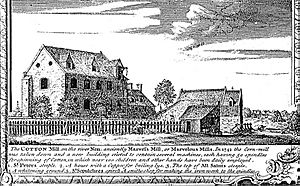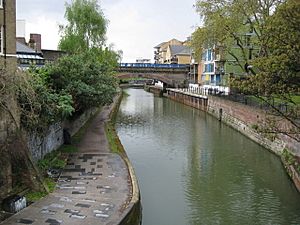Thomas Yeoman facts for kids
Quick facts for kids
Thomas Yeoman
|
|
|---|---|
| Born | 1709 or 1710 Probably Somerset, England
|
| Died | 23 January 1781 (age about 70) |
| Resting place | Bunhill Fields |
| Occupation |
|
| Known for | First president of the Society of Civil Engineers |
|
Notable work
|
Limehouse Cut |
Thomas Yeoman (born around 1709 or 1710, died 1781) was a very important engineer. He worked as a millwright, surveyor, and civil engineer. He helped a lot during the early Industrial Revolution, a time when new machines changed how things were made. Thomas Yeoman also became the first leader of the world's first engineering club, called the Society of Civil Engineers. Today, it's known as the Smeatonian Society of Civil Engineers.
Contents
Early Life in Northampton

We don't know much about where Thomas Yeoman grew up. He was probably born in Somerset, England. We first hear about him in 1741. He was a skilled wheelwright, good at working with metal and building machines for grinding.
A man named Edward Cave hired him to run a special cotton mill in Northampton. This mill used water power to spin cotton. Thomas Yeoman moved there with his wife, Sarah, and their son, James.
Building Machines and Helping the Community
Yeoman quickly became known as a great millwright. He built machines like ventilators, which were invented by a clergyman named Stephen Hales. These machines helped move air around.
Thomas Yeoman also became an active member of the Northampton community. He was an important part of the local Baptist Church. His contributions were recognized when he became the president of the Northampton Philosophical Society. This group met at his house and included other smart people like the inventor William Shipley.
New Skills and Family Life
As Yeoman's reputation grew, he moved to different streets in Northampton. He started building and selling scientific tools. His ventilators were even sold in other countries, like the Netherlands, for use on British ships. In 1744, he also started surveying, which means mapping out land and rivers. He made his first map of the River Nene.
Thomas and Sarah had another son, Samuel. Sadly, Sarah died in 1746. A year later, in 1747, Thomas married Anne Remington. They had a son named Thomas in 1748 and a daughter named Anne in 1752.
Yeoman's skills in surveying continued to grow. In 1752, he drew a map of a large estate. This showed he was becoming very good at mapping land.
Moving to London
In 1756, Thomas Yeoman moved to London. He advertised his services in a popular magazine called The Gentleman's Magazine. He lived in Westminster and started working for the British Admiralty. He installed his ventilators on navy ships and in naval hospitals. He also put ventilators in famous places like the Drury Lane Theatre and the Houses of Parliament.
Joining Important Societies
In the 1760s, he joined the Society of Arts, which was started by his friend William Shipley. He helped other people join this society and was the active chairman of the Committee of Mechanics for many years.
Working on Waterways
When he arrived in London, Yeoman shared his knowledge with a group in Parliament about the River Nene. In 1758, he was hired as a surveyor and engineer for projects on the river. After this, most of his work involved surveying and engineering for many canals and river routes. These included the Stort, Lea, Chelmer, Medway, Stroud, and Thames.
He often worked with another famous engineer, John Smeaton. One of their big achievements was the Limehouse Cut. This was a canal that allowed ships to avoid a winding part of the River Lea, making travel easier. As early as 1763, Thomas Yeoman was called a "surveyor and civil engineer." This was one of the first times this term was used for someone who wasn't in the military. In 1764, he was chosen to be a Fellow of the Royal Society. This was a great honor for his work.
Founding the First Engineering Society
In 1771, Thomas Yeoman, John Smeaton, and other engineers met in London. They decided that civil engineers should form a society. This became the "first group of non-military engineers in the English-speaking world."
Thomas Yeoman was chosen as the first president of this new Society of Civil Engineers. It was later called the Smeatonian Society. He was probably chosen because he was older and very experienced. He was very enthusiastic about this role. He took notes for the first few meetings and even helped pay for some of the society's costs.
Thomas Yeoman died in 1781. He was buried in Bunhill Fields. His work helped shape the early days of engineering and made travel and industry much better.


